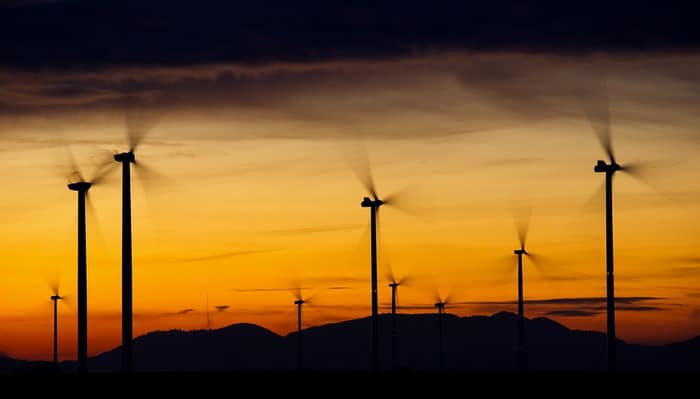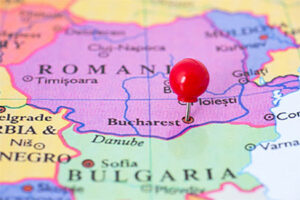How Does Wind Energy Work?

Wind energy works by turning the kinetic energy of the moving air into mechanical energy, and then into electrical energy using a generator.
Mankind has been using wind as a form of energy for thousands of years to power sailboats and windmills. Without the power of the wind, our ancestors would have struggled to travel across oceans, make trade with other nations and explore the world.
Today, we are no longer using the power of the wind to pump water or grind wheat. The kinetic energy of the wind is mainly used today to produce wind energy using wind turbines installed both on land and on sea.
Wind represents air in motion, and is caused by differences in atmospheric pressure and uneven temperatures on the Earth’s surface when heated by the Sun.
The air over the land heats up quicker than the air over the water, and the warm air rises while the cool air rushes in to take its place. This air movement is what we call wind.
The wind is considered a renewable resource exactly like solar power because is produced by the Sun.
However, the wind is less predictable than the rising and the setting of the Sun, despite the fact that wind can blow even during the night.
In 2020, wind power generated about 3 percent of total U.S. electricity. In a few states such as Texas, Oklahoma and Iowa, wind generated more than 40% of the power.
How Do Wind Turbines Work?
Wind turbines harness the kinetic energy of moving air. The air blows over the blades of the turbine creating lift, exactly like the wings of an airplane. This causes the blades to move and rotate a drive shaft that is connected to a generator. The rotational movement of the turbine (blades) and the drive shaft is what creates electricity in the generator.
Similar to solar arrays, wind farms connect several wind turbines together to generate electricity on a large scale.
Wind farms can be built on both land and water. Building wind farms off the coastline of the United States, begins to take shape, an creates an opportunity to generate even more wind power in the country.
Offshore areas have plenty of space available for wind power generation. Wind energy is less reliable than hydropower, but wind farms built off the coastline would be much closer to major cities than many onshore wind farms already existing on land.
Wind Energy Is Paired With Reliable Forms Of Energy
Wind energy is less reliable than other forms of renewable energy such hydro, geothermal, biomass, etc., because winds are variable, and they may stop blowing exactly when the power demand is greatest.
To provide a reliable supply of clean electricity 24/7, wind energy must be paired with other forms of flexible power that can ramp up and down the energy production when needed.
In terms of renewables, biomass, geothermal and hydroelectric power plants can be used as reliable sources of energy for the grid, while wind power as an intermittent one.
Gas-fired power plants can also be paired with wind or solar energy because gas is a reliable form of power.
Is It Possible To Create A World Powered Entirely By Wind Energy?
There are three main factors that can predict how much wind power we can produce using a turbine: the size and the orientation of the blades, the aerodynamic design of the blades and the amount of wind moving the blades.
Today we use horizontal axis and vertical axis turbines. Vertical turbines can pick up wind coming from any direction, but with less efficiency compared to horizontal turbines.
The design of the horizontal axis wind turbines allows blades to capture all the kinetic power of the wind by tracking the wind’s direction and turning the turbine to face the wind. The turning of the turbine to face the wind is called yawing.
In modern wind turbines, wind sensors and computer systems automatically adjust the blades with high precision to capture as much energy possible.
To do this, the shape of the blades has been changed to maximize efficiency. Modern blades are curved like airplane wings and incorporate a twist.
Being produced from fiberglass and resin layers, the blades of the turbine are strong enough to operate in rain, lightning, blistering and sunlight for at least two decades.
Horizontal wind turbines are the most efficient, but even so, to produce energy, wind turbines require the presence of the wind. If the wind doesn’t blow with enough speed, the turbine won’t rotate and energy will not be produced.
At higher altitude, the wind is stronger.
To stay in a windy environment all the time, we have to build very tall wind turbines (over 328 feet or 100 meters) installed in open areas onshore and offshore.
A massive wind turbine installed onshore or offshore can produce enough energy to power about 740 American homes every year.
A wind farm consisting of about 200 wind turbines can produce energy to power about 150,000 American homes every year.
Wind is a free and limitless source of power, but to power the entire planet with wind energy we have to build and install a much larger number of very large wind turbines both onshore and offshore.
What Are 3 Disadvantages Of Wind Energy?
There are several disadvantaged related to wind power.
1. Is an intermittent source of energy
Wind energy is not a constant source of power because the wind doesn’t blow 24/7. Due to this fact, it is pretty difficult to integrate wind power into the electrical grid.
This is the reason why wind energy is paired with reliable sources of power, such as natural gas, because only this way, the grid can provide cleaner energy to all its customers when needed.
2. Wind turbines are limited
No matter how large or efficient a wind turbine is, it has a mathematical limit to how much wind it can convert into electricity.
Albert Betz, a German physicist, calculated that a wind turbine can only capture about 59.3 percent of the wind’s energy because some wind must remain to keep the blades spinning.
3. Can have an impact on the bird and bat population in the area
The rotating blades of the turbine can injure and even kill birds and bats when they cross the rotation plane of the blades.
This way, large wind turbines installed onshore have killed even protected bird species (Bald and Golden Eagles).
4. Can affect the landscape
Some people feel turbines disrupt the natural landscape producing visual pollution.
However, the most amount of wind energy can be generated in open areas, away from civilization, where the wind is not blocked by natural or man-made obstacles.
Installing them in remote areas, wind turbines will have a reduced impact on the landscape.
3. Can produce sound pollution
Large wind turbines installed too close to human settlements, can affect the population due to the sound pollution produced by the rotating blades of the turbine.
To make the turbine work at full capacity, we have to install it in an open area away from places where people live. This way we can produce a large amount of clean power without affecting the quality of people’s life.
What Are 5 Advantages Of Wind Energy?
Wind is produced by the Sun, which means that wind energy has many advantages over fossil fuels.
1. Is a clean source of power
Wind energy is produced by the rotating blades of the turbine. The rotating turbine spins a shaft connected to a generator that produce clean electricity.
This form of power is clean (zero emissions), is free and renewable (is produced by the Sun).
2. Is cost-effective
Once installed onshore, a wind turbine can produce electricity that costs only 1 or 2 cents per kWh (kilowatt-hour).
Giving the fact that a wind turbine can operate at least two decades, we can say that wind energy creates an opportunity to obtain cheap and clean electricity for decades to come.
3. It’s a sustainable form of power
Being created by the Sun that unevenly heats the different layers of air in our atmosphere, wind energy is another form of solar energy.
For as long we have air on the planet and the Sun shines, wind will remain a sustainable source of clean electricity for mankind.
4. Creates new jobs in the U.S. and across the planet
Wind turbine technician is one of the fastest growing job in the United States.
With more than 100,000 workers in the wind industry today, we are expecting to see a growth of 600 percent by the year 2050, in the manufacturing, installation, support services and maintenance in the wind sector.
5. Wind turbines can be installed on existing farms or ranches
Installing a new wind turbine requires a small area of land. This means that these devices that can turn wind into electricity at a very low price, do not affect the land used to install them even if that land is used for agriculture or farming.
Ranchers and farmers can continue to work those lands, and landowners receive an additional income by hosting a wind turbine on their land.
Conclusion
Wind energy is a great source of clean electricity for a future of mankind. Being produced by the kinetic energy of the wind that rotates a turbine, a shaft and then a generator to produce clean power, the wind sector has a great future ahead.





